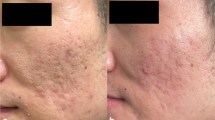Abstract
Ablative fractional laser treatment has been extensively used for resurfacing atrophic acne scars. However, few studies have investigated how the parameters set during laser procedures affect efficacy. In this retrospective study, we examined the relationship between efficacy and Fitzpatrick skin type, gender, age, follow-up duration, energy, and treatment sessions utilizing ablative fractional carbon dioxide (CO2) laser in Asians with Fitzpatrick skin types III–IV. We then analyzed the relationship between outcome and adverse effects including hyperpigmentation. Three blinded dermatologists used the ECCA (Echelle d’Evaluation Clinique des Cicatrices d’Acnluation Clinique des Cicospectively review 82 of 1034 patients who presented at our institution for atrophic acne scar treatment between August 2013 and August 2019. Factors associated with efficacy, including age, gender, Fitzpatrick skin type, energy, treatment sessions, follow-up duration, and pigmentation, were analyzed. 82 patients met inclusion criteria. Patients underwent one to three CO2 laser treatment sessions. Parameter settings for individual patients were consistent across treatments. Mean ECCA scores decreased from 102.70 ± 24.95 to 87.28 ± 24.48 (p ≤ 0.001). The number of treatment sessions and duration of pigmentation lasting shorter than 3 months positively correlated with better outcomes. All patients had erythema, which lasted longer than 3 months in 16 patients (19.51%). Post-inflammatory hyperpigmentation (PIH) affected 60 patients (73.17%) and lasted longer than 3 months in 26 patients (31.71%). One patient experienced hypopigmentation (1.22%), while 8 experienced acne flare-up (9.76%). Post-laser scars occurred in 2 patients (2.44%). Our data suggest that in atrophic acne scar treatment in Asians using fractional CO2 laser, 3 treatment sessions and duration of hyperpigmentation within 3 months have better outcomes regardless of energy, gender, age, Fitzpatrick skin type, follow-up duration, and disease course.



Similar content being viewed by others
References
Taylor M, Gonzalez M, Porter R (2011) Pathways to inflammation: acne pathophysiology. Eur J Dermatol 21(3):323–333. https://doi.org/10.1684/ejd.2011.1357
Bhargava S, Cunha PR, Lee J, Kroumpouzos G (2018) Acne Scarring Management: Systematic Review and Evaluation of the Evidence. Am J Clin Dermatol 19(4):459–477. https://doi.org/10.1007/s40257-018-0358-5
Sadick NS, Cardona A (2018) Laser treatment for facial acne scars: a review. J Cosmet Laser Ther 20(7–8):424–435. https://doi.org/10.1080/14764172.2018.1461230
Ortiz AE, Tremaine AM, Zachary CB (2010) Long-term efficacy of a fractional resurfacing device. Lasers Surg Med 42(2):168–170. https://doi.org/10.1002/lsm.20885
Sardana K, Manjhi M, Garg VK, Sagar V (2014) Which type of atrophic acne scar (ice-pick, boxcar, or rolling) responds to nonablative fractional laser therapy? Dermatol Surg 40(3):288–300. https://doi.org/10.1111/dsu.12428
Alexiades-Armenakas MR, Dover JS, Arndt KA (2008) The spectrum of laser skin resurfacing: nonablative, fractional, and ablative laser resurfacing. J Am Acad Dermatol 58(5):719–740. https://doi.org/10.1016/j.jaad.2008.01.003
Tatlıparmak A, Aksoy B, Shishehgarkhaneh LR, Gökdemir G, Koç E (2020) Use of combined fractional carbon dioxide laser and fractional microneedle radiofrequency for the treatment of acne scars: a retrospective analysis of 1-month treatment outcome on scar severity and patient satisfaction. J Cosmet Dermatol 19(1):115–121. https://doi.org/10.1111/jocd.13004
Helou J, Korkomaz J, Stephan F, Soutou B (2020) Searching predictive factors of efficacy and safety in a fractional CO2 laser. Dermatol Ther 33(6):e13985. https://doi.org/10.1111/dth.13985
Karmisholt KE, Haerskjold A, Karlsmark T, Waibel J, Paasch U, Haedersdal M (2018) Early laser intervention to reduce scar formation - a systematic review. J Eur Acad Dermatol Venereol 32(7):1099–1110. https://doi.org/10.1111/jdv.14856
Bjørn M, Stausbøl-Grøn B, BraaeOlesen A, Hedelund L (2014) Treatment of acne scars with fractional CO2 laser at 1-month versus 3-month intervals: an intra-individual randomized controlled trial. Lasers Surg Med 46(2):89–93. https://doi.org/10.1002/lsm.22165
Fournier N, Mordon S (2005) Nonablative remodeling with a 1,540 nm erbium:glass laser. Dermatol Surg 31(9 Pt 2):1227–1236. https://doi.org/10.1111/j.1524-4725.2005.31931
Ong MW, Bashir SJ (2012) Fractional laser resurfacing for acne scars: a review. Br J Dermatol 166(6):1160–1169. https://doi.org/10.1111/j.1365-2133.2012.10870.x
Paasch U, Haedersdal M (2011) Laser systems for ablative fractional resurfacing. Expert Rev Med Devices 8(1):67–83. https://doi.org/10.1586/erd.10.74
Helbig D, Bodendorf MO, Grunewald S, Kendler M, Simon JC, Paasch U (2009) Immunohistochemical investigation of wound healing in response to fractional photothermolysis. J Biomed Opt 14(6):064044. https://doi.org/10.1117/1.3275479
Kim S, Cho KH (2009) Clinical trial of dual treatment with an ablative fractional laser and a nonablative laser for the treatment of acne scars in Asian patients. Dermatol Surg 35(7):1089–1098. https://doi.org/10.1111/j.1524-4725.2009.01193.x
Kim HJ, Kim TG, Kwon YS, Park JM, Lee JH (2009) Comparison of a 1,550 nm Erbium: glass fractional laser and a chemical reconstruction of skin scars (CROSS) method in the treatment of acne scars: a simultaneous split-face trial. Lasers Surg Med 41(8):545–549. https://doi.org/10.1002/lsm.20796
Mahmoud BH, Srivastava D, Janiga JJ, Yang JJ, Lim HW, Ozog DM (2010) Safety and efficacy of erbium-doped yttrium aluminum garnet fractionated laser for treatment of acne scars in type IV to VI skin. Dermatol Surg 36(5):602–609. https://doi.org/10.1111/j.1524-4725.2010.01513.x
Yuan XH, Zhong SX, Li SS (2014) Comparison study of fractional carbon dioxide laser resurfacing using different fluences and densities for acne scars in Asians: a randomized split-face trial. Dermatol Surg 40(5):545–552. https://doi.org/10.1111/dsu.12467
Upadhyay PR, Ho T, Abdel-Malek ZA (2021) Participation of keratinocyte- and fibroblast-derived factors in melanocyte homeostasis, the response to UV, and pigmentary disorders. Pigment Cell Melanoma Res 34(4):762–776. https://doi.org/10.1111/pcmr.12985
de Souza KS, Cantaruti TA, Azevedo GM Jr et al (2015) Improved cutaneous wound healing after intraperitoneal injection of alpha-melanocyte-stimulating hormone. Exp Dermatol 24(3):198–203. https://doi.org/10.1111/exd.12609
Mu YZ, Jiang L, Yang H (2019) The efficacy of fractional ablative carbon dioxide laser combined with other therapies in acne scars. Dermatol Ther 32(6):e13084. https://doi.org/10.1111/dth.13084
Funding
Jiangsu Provincial Basic Research Program and Natural Science Foundation: Youth Project [grant numbers: BK20170164] and CAMS Innovation Fund for Medical Sciences, CIFMS-2021-I2M-1–001.
Author information
Authors and Affiliations
Corresponding author
Ethics declarations
Conflict of interest
The authors declare no conflicts of interest.
Additional information
Publisher's Note
Springer Nature remains neutral with regard to jurisdictional claims in published maps and institutional affiliations.
Rights and permissions
About this article
Cite this article
Fang, F., Yang, H., Liu, X. et al. Treatment of acne scars with fractional carbon dioxide laser in Asians: a retrospective study to search for predicting factors associated with efficacy. Lasers Med Sci 37, 2623–2627 (2022). https://doi.org/10.1007/s10103-022-03528-w
Received:
Accepted:
Published:
Issue Date:
DOI: https://doi.org/10.1007/s10103-022-03528-w




